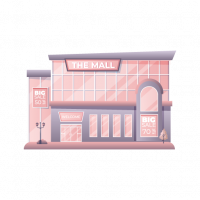Geo Fencing | Helps Brands | Target Shoppers | Digital Marketing

In today’s competitive retail landscape, brands are constantly seeking innovative ways to engage consumers and drive sales. One powerful tool that has emerged is geo-fencing—a location-based marketing strategy that enables brands to target shoppers in real time. In this article, we’ll explore what geo-fencing is, how it works, and the ways it can benefit businesses.
What Is Geo-Fencing?
Geo-fencing is a location-based technology that uses GPS,
RFID, Wi-Fi, or cellular data to create a virtual boundary around a specific
geographic area. When a mobile device enters or exits this pre-defined area, it
triggers an automated response, such as sending a push notification, text
message, or targeted advertisement.
How Does Geo-Fencing Work?
The process of geo-fencing typically involves the following
steps:
- Define
the Target Area: Businesses set up a virtual perimeter around a
physical location, such as a store or event venue.
- Integrate
with Mobile Apps: Geo-fencing technology is integrated into a mobile
app or advertising platform.
- Trigger
Notifications: When a user enters or exits the area, the system sends
out relevant notifications or promotions.
- Analyze
Data: Brands track engagement metrics to measure the effectiveness of
the campaign.
Benefits of Using Geo-Fencing for Brands
- Real-Time
Customer Engagement: Geo-fencing allows brands to connect with
consumers at the right place and time, increasing the likelihood of
conversion.
- Personalized
Marketing: By leveraging data on customer behavior and location,
brands can deliver tailored offers and messages.
- Enhanced
Customer Experience: Timely and relevant notifications improve the
overall shopping experience, fostering brand loyalty.
- Data-Driven
Insights: Geo-fencing provides valuable data on customer movement
patterns and engagement, helping brands optimize their strategies.
- Cost-Effective
Targeting: Compared to traditional advertising, geo-fencing can be
more efficient, targeting only those in proximity to the store.
Real-Life Examples of Geo-Fencing Success
Retail giants like Starbucks and Sephora have successfully
employed geo-fencing to attract nearby customers with exclusive deals. For
instance, Starbucks uses geo-fencing to send special offers to customers within
walking distance of their stores, boosting foot traffic and sales.
Challenges and Considerations
While geo-fencing offers many advantages, brands must also
consider potential challenges, such as privacy concerns and the need for
customer consent. Transparency and clear communication about data usage are
essential for maintaining consumer trust.
Conclusion
Geo-fencing is a game-changer for brands looking to target
shoppers in real time. By delivering personalized, location-based messages,
businesses can increase customer engagement, drive sales, and build lasting
loyalty. As more consumers embrace mobile shopping, geo-fencing will continue
to be a valuable tool in modern marketing strategies.






















Leave a Comment